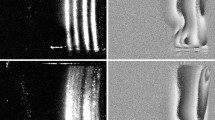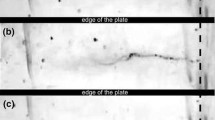Abstract
Holographic particle image velocimetry is a promising technique to probe and characterize complex flow dynamics since it is a truly three-dimensional (3D) three-component measurement technique. The technique simply records the coherent light scattered by small seeding particles that are assumed to faithfully follow the flow and uses it to reconstruct the event afterward. Reconstruction of the event is usually performed using a digital video microscope mounted on a 3D translation stage. The microscope records the intensity only which consequently results in loss of phase information. The objective of this paper is to develop and apply digital holographic microscopy with the aim to recover the phase information. Digital holographic microscopy has immense potentials in microscale solid and fluid measurements as it offers the possibility of digital wavefront processing by manipulating amplitude and phase of the recorded holograms. In this paper, we have developed an off-axis digital holographic microscope to capture both amplitude and phase of the reconstructed object simultaneously. This inherently solves twin image problem in the recorded digital holograms. The microscope was integrated into the reconstruction system and was successfully used to digitize holographic images of 10 μm polystyrene spheres and 1 μm olive oil droplets. The spatial resolution of the system is 0.63 μm, and the field of view is 1250 × 625 μm2. A 3D holographic reconstruction using a k-space analysis (wave-vector) of the optical field is applied to numerically refocus the images. Another potential application includes digital wavefront processing to compensate for aberration in the images.
Access provided by Autonomous University of Puebla. Download conference paper PDF
Similar content being viewed by others
Keywords
These keywords were added by machine and not by the authors. This process is experimental and the keywords may be updated as the learning algorithm improves.
1 Introduction
Holographic particle image velocimetry (HPIV) is a promising technique to probe and characterize complex flow dynamics since it is a truly three-dimensional (3D) three-component measurement technique. The technique relies on recording the coherent light scattered by small seeding particles that are assumed to faithfully follow the flow and uses it to reconstruct the event afterward. The essence of holographic imaging lies in the fact that, when coherent light propagates through a semi-transparent object, its amplitude and phase get modulated due to light-matter interaction. This effectively means that the entire 3D structure of the object is coded in the form of scattered wavefronts which eventually incident on to holographic films [1]. However, reconstruction of the event is usually performed using a digital video microscope mounted on a 3D translation stage [2]. The microscope records the intensity only which consequently results in loss of phase information.
On the other hand, a new application of holography in the field of optical microscopy has introduced a new imaging technology, known as digital holographic microscopy [3]. It is essentially similar to classical holography except that CCD sensors are used instead of holographic film emulsion [4]. For this reason, one can directly record information about the phase and amplitude of the object’s wavefront and thus numerically reconstruct sectional images of specimens at different depths from only a single digital hologram [3]. The remarkable aspect of digital reconstruction is the topic of the present study. Digital holographic microscopy has proved to be useful in solid and fluid measurements since it allows digital processing of the wavefronts [5, 6]. In comparison to HPIV, the measurement volume with digital holographic microscopy is significantly less due to inferior pixel resolution of the imaging sensor.
In this paper, an off-axis digital holographic microscope was developed and integrated in the hologram reconstruction system to capture both amplitude and phase of the reconstructed object simultaneously. By combining the power of optics with digital holography , one is able to perform fluid measurements in a bigger volume with microns resolution. In the following section, the construction of the microscope is first discussed.
2 Digital Holographic Microscope
Unlike typical HPIV reconstruction approach which utilised a microscope objective [2], the novel approach of this study involves the employment of a digital holographic microscope (DHM) that allows simultaneous digitisation of holographic particle image in both amplitude and phase formats. The schematic of the DHM assembly is illustrated in Fig. 1.
The reconstructed image is first magnified using a 10× microscope objective. To compensate for phase curvature [7] introduced by the microscope objective to the object wave, the reference wave of an approximately the same curvature was introduced at the fibre tip with numerical aperture of about 0.10–0.14. The magnified image of the reconstructed object and the reference wave interferes on the CCD plane with an intersecting angle, θccd less than that of Nyquist’s limit. The interference patterns are finally recorded on a Lumenera 10.8 MPixel digital camera with pixel size of 9 μm2.
An off-axis digital hologram of the object is finally recorded. It is found that the spatial resolution of the system is 0.63 μm, and the field of view is 1250 × 625 μm2. The DHM is then mounted on a 3D-motorized stage, permitting detailed measurement in a much bigger imaging volume (>1003 mm3) with micrometres resolution. Similar principles of digital holographic recording and reconstruction that have been described in [8] are utilised to process the digital holograms. The developed DHM is tested in the following section.
3 Experiment
To verify the applicability of the DHM for large scale measurement, two different particle sizes were tested: (a) 10 ± 0.05 μm NIST traceable polystyrene microspheres of density 1.05 g/cm3 (Thermo Fisher Scientific) in aqueous form, and (b) 1 ± 0.3 μm produced using a TSI six-jet atomiser (Model 9306) that was set to run on two jets at about 100 kPa. These objects were recorded on two separate holograms.
These objects were holographically recorded using an off-axis recording setup. A frequency doubled Nd:YAG laser operating at 532 nm (Continuum Inc.) was used for the illumination and the beam energy was equally split into the respective object and reference paths. The laser was set producing a single pulse of 1.3 ns width with energy of 84 μJ/cm2. A collimated reference beam was carefully produced which incident on the plane of the hologram at Brewster’s angle whilst a diverging object beam was used to illuminate the objects. The interference was recorded on a Slavich VRP-M holographic plate of Russian origin (having resolving power of 3000 lines/mm). The hologram was developed in Kodak D-19 for about 3 min maintained at ~25 °C during the development process. There was no fixing or bleaching step adopted. Once the hologram was developed, the reconstructed image of the (aberrated) objects was digitised using the purpose built digital holographic microscope as follows.
An experimental setup as shown in Fig. 2 was used to reconstruct the off-axis optical hologram. The first step involved an optical reconstruction of the hologram using a phase-conjugate of the reference wave, producing real image of the objects. In this setup, a single longitudinal mode (CNI MSL-III-532 laser, 532 nm, 80 mW) laser with long coherence length of about 50 m was used and split by a 90:10 plate beam splitter, where most of the power is directed towards reconstructing the hologram. The remaining power was transmitted via an optical fibre to form an off-axis reference wave. By referring to Fig. 2, the intensity of the reference wave was adjusted using a variable neutral density filter and its polarization angle was compensated by a linear polarizer. Thereafter, the DHM was used to scan in a relatively large three-dimensional space and simultaneously digitise both amplitude and phase information of the images.
Hologram reconstruction setup and utilisation of an off-axis digital holographic microscope to digitise both the amplitude and phase of the reconstructed objects. A conjugate reference wave is initially employed to reconstruct the hologram, and eventually the reconstructed images are digitised using the DHM
4 Results and Discussion
The developed DHM was used to capture both amplitude and phase of the reconstructed 10 μm polystyrene sphere and 1 μm olive oil droplet from two separate optical holograms. A 3D holographic reconstruction using a k-space analysis (wave-vector) of the optical field is applied to numerically refocus the images [8]. This indirectly overcomes limited resolution along the z-axis imposed by the 3D mechanical translation state. The demodulated amplitude images after numerical refocus are shown in Fig. 3.
Further examination reveals that the images appear to be influenced by aberrations. It can be seen that as the particle size gets smaller the severity of aberration is less pronounced. It is noted that aberration severely degrades the image quality and this eventually would make particle centroid identification problematic. Compensation of the aberration in the particle images will be the subject of our future study.
5 Conclusions
Holographic particle image velocimetry is truly the key for three-dimensional three-component fluid flow measurement over a deep measuring volume. Digitisation of the reconstructed images using a video microscope however results in loss of useful phase information. In this paper, a new off-axis digital holographic microscope has been developed with the aim to recover the loss. The developed microscope was successfully used to digitize holographic images of 10 μm polystyrene spheres and 1 μm olive oil droplets. The spatial resolution of the system is 0.63 μm, and the field of view is 1250 × 625 μm2. We have demonstrated the benefits of having both phase and amplitude for numerical refocus of the object. The DHM has the potential for digital wavefront processing to compensate for aberration found in the images.
References
D. Gabor, A new microscopic principle. Nature 161(4098), 777–778 (1948)
K.D. Hinsch, Holographic particle image velocimetry. Meas. Sci. Technol. 13(7), R61 (2002)
U. Schnars, W. Jueptner, Digital holographic microscopy. Digital holography: digital hologram recording, numerical reconstruction, and related techniques, pp. 95–99 (2005)
H. Meng, G. Pan, Y. Pu, S.H. Woodward, Holographic particle image velocimetry: from film to digital recording. Meas. Sci. Technol. 15(4), 673 (2004)
T. Colomb, E. Cuche, F. Charrière, J. Kühn, N. Aspert, F. Montfort, P. Marquet, C. Depeursinge, Automatic procedure for aberration compensation in digital holographic microscopy and applications to specimen shape compensation. Appl. Opt. 45(5), 851–863 (2006)
S. Satake, T. Kunugi, K. Sato, T. Ito, H. Kanamori, J. Taniguchi, Measurements of 3D flow in a micro-pipe via micro digital holographic particle tracking velocimetry. Meas. Sci. Technol. 17(7), 1647 (2006)
J.W. Goodman, Introduction to Fourier Optics. Roberts & Company Publishers, Englewood (1996)
S.A. Wormald, J. Coupland, Particle image identification and correlation analysis in microscopic holographic particle image velocimetry. Appl. Opt. 48(33), 6400–6407 (2009)
Acknowledgments
The authors are grateful to Prof. J.M. Coupland (Loughborough University) for useful discussion and access given to perform the experiments.
Author information
Authors and Affiliations
Corresponding author
Editor information
Editors and Affiliations
Rights and permissions
Copyright information
© 2015 Springer International Publishing Switzerland
About this paper
Cite this paper
Tamrin, K.F., Rahmatullah, B., Samuri, S.M. (2015). Development of an Off-Axis Digital Holographic Microscope for Large Scale Measurement in Fluid Mechanics. In: Polychroniadis, E., Oral, A., Ozer, M. (eds) 2nd International Multidisciplinary Microscopy and Microanalysis Congress. Springer Proceedings in Physics, vol 164. Springer, Cham. https://doi.org/10.1007/978-3-319-16919-4_12
Download citation
DOI: https://doi.org/10.1007/978-3-319-16919-4_12
Published:
Publisher Name: Springer, Cham
Print ISBN: 978-3-319-16918-7
Online ISBN: 978-3-319-16919-4
eBook Packages: Physics and AstronomyPhysics and Astronomy (R0)







